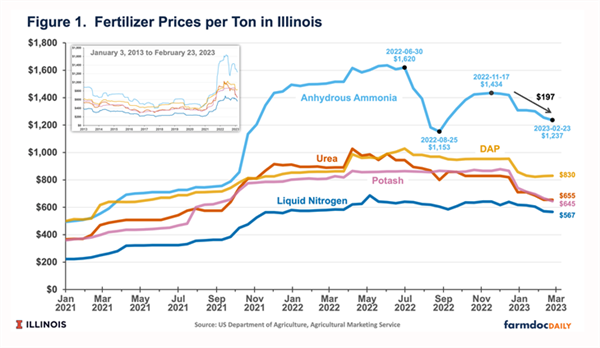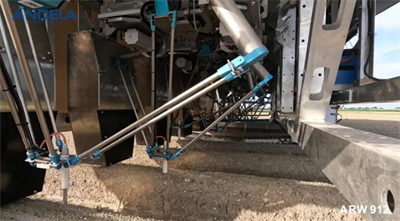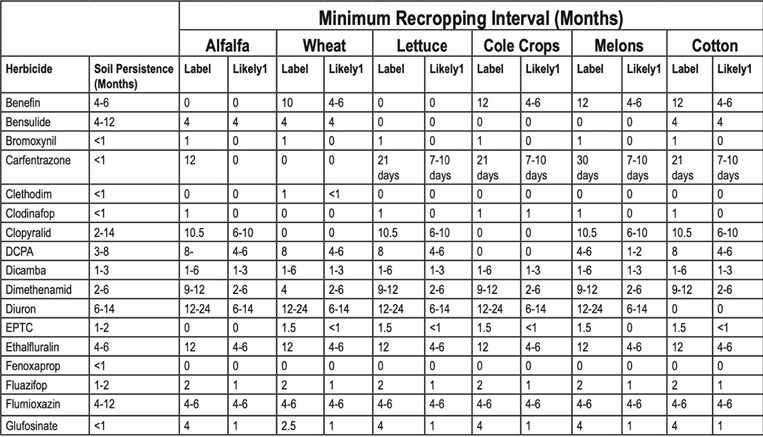
These large fluctuations have been largely due to changes in trade flows with Russia because of the tensions in the region, sanctions imposed on Russia, inflation, and other pandemic-related complications with transportation logistics. Collectively, expensive fertilizer prices have been a challenge globally and certainly in our crop production systems of the desert Southwest.
Recently, several retail fertilizers have varied significantly in the market trends. For example, in May 2023 about half of the major retail fertilizers are higher compared to April prices and the other half has lower prices than last month (Quinn, 2023).
Urea (46-0-0) has gone up 6% in retail markets since last month with an average price of $664/ton. A few weeks ago, urea was below $600/ton for the first time since late 2021. Similarly, diammonium phosphate (18-46-0), monoammonium phosphate (11-52-0), and urea ammonium nitrate (32-0-0) had an average the past month of $517/ton.
In contrast, anhydrous ammonia (82-0-0) has had an average price recently of $910/ton, which is down about 9% in price from April 2023. Several other major fertilizers have been lower in price the past month. Muriate of potash (KCl, 0-0-60) had an average price in the past month of $627/ton, ammonium polyphosphate (10-34-0) average price has been $739/ton, and urea ammonium nitrate (UAN-32, 32-0-0) average price has been $423/ton this month.
Note that several of the major fertilizer materials come in different forms. For example, urea ammonium nitrate (UAN) is 28% N in some materials and 32% N in another common form. Also, monoammonium phosphate (MAP) can have N concentrations of 10-12% and P2O5 concentrations of 48-61% with 11-52-0 being probably the most common form in the market.
Considering the overall trends in the past few years, international fertilizer prices have been generally decreasing since the summer of 2022. Today, international fertilizer prices are back in a range close to early 2021. International fertilizer prices are not expected to drop below pre-pandemic levels, primarily due to global inflation that generates an increase in production and transportation costs (Figure 1).
Several expert sources in the fertilizer industry are projecting a drop in international fertilizer prices in the coming months by approximately 50% of the prices experienced last year. Accordingly, many fertilizer importers are waiting to ship to markets and farmers are often waiting and watching for the projected drop in fertilizer prices to materialize before purchasing (Schnitkey et al., 2023).
Despite the high degree of volatility in international fertilizer markets and the limited availability of fertilizers in some crop production sectors that have recently been experienced, it is expected that the downward trends will continue.
Looking ahead, many experts in the international fertilizer industry are recommending for producers to not wait until too late to purchase fertilizers for upcoming crops, utilize economies of scale when purchasing fertilizers materials as much as possible, and of course watch the trends in fertilizer markets. International logistics in the fertilizer industry, including shipping, transfer, and distribution of fertilizer cargo is proving to be very important in realizing a more stable fertilizer market for the future.

Figure 1. Example of fluctuations in fertilizer prices per ton of material from
January 2021 through March 2023. Source: Schnitkey et al. 2023
References:
Schnitkey, G., N. Paulson, C. Zulauf and J. Baltz. 2023. Fertilizer Prices and Company Profits Going into Spring 2023. farmdoc daily (13):36, Department of Agricultural and Consumer Economics, University of Illinois at Urbana-Champaign, 28 February 2023.
Quinn, R. 2023. DTN Retail Fertilizer Trends: Fertilizer prices moving in two directions. DTN Newsletter, 17 May 2023. https://www.dtnpf.com/agriculture/web/ag/crops/article/2023/05/17/fertilizers-moving-two-directions
Frost and freeze damage affect countless fruit and vegetable growers leading to yield losses and occasionally the loss of the entire crop. Frost damage occurs when the temperature briefly dips below freezing (32°F).With a frost, the water within plant tissue may or may not actually freeze, depending on other conditions. A frost becomes a freeze event when ice forms within and between the cell walls of plant tissue. When this occurs, water expands and can burst cell walls. Symptoms of frost damage on vegetables include brown or blackening of plant tissues, dropping of leaves and flowers, translucent limp leaves, and cracking of the fruit. Symptoms are usually vegetable specific and vary depending on the hardiness of the crop and lowest temperature reached. A lot of times frost injury is followed by secondary infection by bacteria or opportunist fungi confusing with plant disease.
Most susceptible to frost and freezing injury: Asparagus, snap beans, Cucumbers, eggplant, lemons, lettuce, limes, okra, peppers, sweet potato
Moderately susceptible to frost and freezing injury: Broccoli, Carrots, Cauliflower, Celery, Grapefruit, Grapes, Oranges, Parsley, Radish, Spinach, Squash
Least susceptible to frost and freezing injury: Brussels sprouts, Cabbage, Dates, Kale, Kohlrabi, Parsnips, Turnips, Beets
More information:
With the advent of low-cost computing systems that can identify and locating crop and weed plants in real-time, there’s been an explosion in the interest, investment and development of technologies for robotic/automated weed control. A quick internet search will reveal over 50 companies or university research groups working in this space. You are probably familiar with many of these as they are domestically based and have been discussed in previous articles, but there are also numerous efforts being made in Europe that may be of interest. One of these is highlighted here. In future articles, I’ll discuss additional technologies.
Andela Techniek & Innovatie1 is a Dutch company who appears to be making good progress with an innovative robotic weeding machine (Fig. 1). The solar powered device spans 29.5 feet and is equipped with 12 robotic delta arms for removing in-row weeds (Fig. 2). A camera-based imaging system is used to differentiate crop plants from weeds and provide coordinates of targeted weeds to the delta arms. Each delta arm is equipped with an end-effector that uses heat to kill the weed when it comes into contact with it. A company video showing the device operating in carrot and onion crops can be found by clicking here or on the images below.
Stay tuned!
Fig. 1. Andela Techniek & Innovatie1 solar powered robotic weeding machine. (Photo credits: Andela Techniek & Innovatie)

Fig. 2. Delta arms and end effector of Andela Techiek &
Innovatie1 robotic weeding machine. (Photo credits:
Andela Techniek & Innovatie)
The IPM team has received questions about how to evaluate possible crop injury from herbicides that were applied in previous seasons. As we know residual soil activity is very useful when we needed but we must be very careful when the following crop is sensitive. Potential injury is affected by soil type, watering methods, weather, tillage, organic matter, or the combination of these factors.
The following is a chart that “Minimum Recroping Interval” contains the rotational crop interval and soil persistence of herbicides for the major crops and herbicides used in the desert. You can find this chart in the PCA Study Guide Section VI-26.

During 2014-2018 we ran an HPLC (High Pressure Liquid Chromatograph) in our Lab at the Ag. Center to quantify soil and plant herbicide residues free of charge. Currently we don’t have this equipment available so, we helped growers and PCAs evaluate potential herbicide injury using our greenhouses at the Yuma Ag Center (YAC). A basic bioassay can be done just by growing sensitive plants in pots containing soil from the field in question. Even though bioassays are often done with plants that are sensitive to the herbicide used, it is reasonable to use the crop and variety that will be planted.
Also, it is very important to collect small amounts (top 2-4 inches) from several areas of the field. Herbicide concentrations often changes within fields, so separate samples should be collected and labeled to indicate which block they come from.
We are also doing some field evaluations right now with bensulide and metolachlor in spinach at the UA YAC to answer some of your questions and results will be shared soon in this newsletter. If you have a suggestion or herbicide injury test or bioassay you want to run, please contact us at AZVegIPM-Team@email.arizona.edu.
Results of pheromone and sticky trap catches can be viewed here.
Corn earworm: CEW moth counts remain at low levels in all areas, well below average for this time of year.
Beet armyworm: Trap increased areawide; above average compared to previous years.
Cabbage looper: Cabbage looper counts decreased in all areas; below average for this time of season.
Diamondback moth: DBM moth counts decreased in most areas. About average for this time of the year.
Whitefly: Adult movement beginning at low levels, average for early spring.
Thrips: Thrips adult counts reached their peak for the season. Above average compared with previous years.
Aphids: Aphid movement decreased in all areas; below average for late-March.
Leafminers: Adults remain low in most locations, below average for March.